The Effects of an Automatic Flushing Valve on the Hydraulic Performance of a Subsurface Drip Irrigation System for Alfalfa
Abstract
1. Introduction
2. Materials and Methods
2.1. Overview of the Experimental Area
2.2. Experimental Design and Field Management
2.3. Testing Methods and Procedures
2.3.1. Hydraulic Performance of the Automatic Flushing Valve (AFV)
2.3.2. Emitter Hydraulic Performance
2.3.3. Hydraulic Performance of the Water Supply Control Unit
2.4. Data Analysis
3. Results
3.1. Fitting of Measured and Calculated Hydraulic Performance of the AFV
3.2. Hydraulic Performance of the AFVs
3.3. Hydraulic Performance of the Subsurface Drip Irrigation System
4. Discussion
4.1. Variation in the AFV’s Hydraulic Performance
4.2. Variations in the Hydraulic Performance of the Subsurface Drip Irrigation System
4.3. Temporal and Spatial Distributions of Emitter Clogging in Subsurface Drip Irrigation Systems
4.4. Engineering Significance
5. Conclusions
Author Contributions
Funding
Institutional Review Board Statement
Data Availability Statement
Conflicts of Interest
Abbreviations
| SDI | Subsurface drip irrigation |
| AFV | Automatic flushing valve |
| FD | Flushing duration |
| FQ | Flushing water volume |
| FV | Flushing velocity |
| CV | Coefficient of variation |
| T | The daily average temperature |
| E | Elasticity |
| Dra | The average relative flow rate |
| Cu | Irrigation uniformity |
| TN | Total nitrogen |
| TP | Total phosphorus |
| TSS | Total suspended solids |
| TDS | Total dissolved solids |
| TH | Total concentration of calcium and magnesium ions |
References
- Kou, D.; Su, D.; Wu, D.; Li, Y. Effects of regulated deficit irrigation on water consumption, hay yield and quality of alfalfa under subsurface drip irrigation. Trans. Chin. Soc. Agric. Eng. 2014, 30, 116–123. [Google Scholar] [CrossRef]
- Olszewska, M. Micronutrient Content of Aboveground Biomass as Influenced by Different Proportions of Medicago media Pers. in Two-Component Alfalfa–Grass Mixtures. Agriculture 2024, 14, 2205. [Google Scholar] [CrossRef]
- Nery, D.; Palottini, F.; Farina, W.M. The South American Black Bumblebee (Bombus pauloensis) as a Potential Pollinator of Alfalfa (Medicago sativa). Agriculture 2024, 14, 2192. [Google Scholar] [CrossRef]
- General Administration of Customs of China. China Customs Statistical Yearbook 2022; China Customs Press: Beijing, China, 2022.
- Lu, Q.; Qi, G.; Yin, M.; Kang, Y.; Ma, Y.; Jia, Q.; Wang, J.; Jiang, Y.; Wang, C.; Gao, Y.; et al. Alfalfa Cultivation Patterns in the Yellow River Irrigation Area on Soil Water and Nitrogen Use Efficiency. Agronomy 2024, 14, 874. [Google Scholar] [CrossRef]
- National Development and Reform Commission, Ministry of Agriculture and Rural Affairs, National Forestry and Grassland Administration. Opinions on Promoting the High-Quality Development of the Forage Industry. 2024. Available online: https://www.ndrc.gov.cn/xxgk/zcfb/tz/202411/t20241113_1394430.html (accessed on 20 January 2025).
- Zheng, H.; Wang, B.; Cao, X.; Wu, J.; Yan, H.; Tian, D. Optimization of Subsurface Drip Irrigation Schedule of Alfalfa in Northwest China. Water 2023, 15, 2242. [Google Scholar] [CrossRef]
- Mo, Y.; Li, G.; Wang, D.; Lamm, F.R.; Wang, J.; Zhang, Y.; Gong, S. Planting and preemergence irrigation procedures to enhance germination of subsurface drip irrigated corn. Agric. Water Manag. 2020, 242, 106412. [Google Scholar] [CrossRef]
- Gao, N.; Mo, Y.; Wang, J.; Yang, L.; Gong, S. Effects of Flow Path Geometrical Parameters on the Hydraulic Performance of Variable Flow Emitters at the Conventional Water Supply Stage. Agriculture 2022, 12, 1531. [Google Scholar] [CrossRef]
- Lamm, F.R. Advantages and Disadvantages of Subsurface Drip Irrigation. In Proceedings of the International Meeting on Advances in Drip/Micro Irrigation, Puerto de La Cruz, Spain, 2–5 December 2002; pp. 1–13. [Google Scholar]
- Tayel, M.Y.; Pibars, S.K.; Mansour, H.A.G. Effect of drip irrigation method, nitrogen source, and flushing schedule on emitter clogging. Agric. Sci. 2013, 4, 131–137. [Google Scholar] [CrossRef]
- Alam, M.; Trooien, T.P.; Rogers, D.H.; Dumler, T.J. An efficient irrigation technology for alfalfa growers. J. Ext. 2002, 40, 15. [Google Scholar]
- Hutmacher, R.B.; Phene, C.J.; Mead, R.M.; Shouse, P.; Clark, D.; Vail, S.S.; Fargerlund, J. Subsurface Drip and Furrow Irrigation Comparison with Alfalfa in the Imperial Valley. In Proceedings of the 2001 California Alfalfa & Forage Symposium, Modesto, CA, USA, 12–13 December 2001; pp. 11–13. [Google Scholar]
- Yang, K.; Zhao, J.; Wang, X.; Ma, C.; Zhang, Q. Effects of Different Irrigation Methods and Phosphorus Application on Alfalfa Yield, Quality and Water and Phosphorus Use Efficiency. Trans. Chin. Soc. Agric. Eng. 2023, 39, 130–138. [Google Scholar] [CrossRef]
- Guo, X.; Li, W. Effects of Different Irrigation Methods on Alfalfa Yield and Weed Occurrence. Xinjiang Agric. Sci. 2014, 51, 2079–2084. [Google Scholar]
- Nakayama, F.S.; Bucks, D.A. Water quality in drip/trickle irrigation: A review. Irrig. Sci. 1991, 12, 187–192. [Google Scholar] [CrossRef]
- Pei, Y.; Li, Y.; Liu, Y.; Zhou, B.; Shi, Z.; Jiang, Y. Eight emitters clogging characteristics and its suitability under on-site reclaimed water drip irrigation. Irrig. Sci. 2014, 32, 141–157. [Google Scholar] [CrossRef]
- Li, Y.; Zhou, B.; Yang, P. Research advances in drip irrigation emitter clogging mechanism and controlling methods. J. Hydraul. Eng. 2018, 49, 103–114. [Google Scholar] [CrossRef]
- Jia, J.; Zhang, S.; Zheng, H. Study on the Clogging Rate of Drip Irrigation under the Condition of Buried Drip Irrigation. China Rural. Water Hydropower 2019, 2, 98–101. [Google Scholar]
- Enciso-Medina, J.; Multer, W.L.; Lamm, F.R. Management, maintenance, and water quality effects on the long-term performance of subsurface drip irrigation systems. Appl. Eng. Agric. 2011, 27, 969–978. [Google Scholar] [CrossRef]
- Mo, Y.; Zhao, X.; Wang, J.; Zhang, Y.; Gong, S.; Xia, H.; Wang, Y. Design and Structural Optimization of the Automatic Flushing Valve with Exhaust Function. Trans. Chin. Soc. Agric. Eng. 2022, 38, 72–79. [Google Scholar] [CrossRef]
- Ma, C.; Jiang, C.; Li, Y.; Shi, N.; Liu, S.; Hu, X.; Liu, Z.; Sun, Z.; Muhammad, T. Effect of lateral flushing on emitter clogging in drip irrigation using high-sediment water. Agric. Water Manag. 2024, 293, 108702. [Google Scholar] [CrossRef]
- Song, P.; Li, Y.; Li, J.; Pei, Y. Chlorination with lateral flushing controlling drip irrigation emitter clogging using reclaimed water. Trans. Chin. Soc. Agric. Eng. 2017, 33, 80–86. [Google Scholar] [CrossRef]
- Wang, H.; Wang, C.; Wang, J.; Qiu, X.; Wang, S.; Li, G. Flushing control strategies to improve the stability of a biogas slurry drip irrigation system: Behavioral characteristics and mechanisms. J. Environ. Manag. 2023, 326, 116792. [Google Scholar] [CrossRef]
- Zhao, X.; Mo, Y.; Xia, H.; Gong, Y.; Wang, J.; Zhang, Y.; Gong, S.; Li, Q. Hydraulic performance of automatic flushing valve at the end of dripline. J. Irrig. Drain. 2021, 40, 105–112. [Google Scholar] [CrossRef]
- Gao, H.; Mo, Y.; Wu, F.; Wang, J.; Gong, S. Impact of Elastic Diaphragm Hardness and Structural Parameters on the Hydraulic Performance of Automatic Flushing Valve. Water 2023, 15, 287. [Google Scholar] [CrossRef]
- Li, W.; Mo, Y.; Wang, Z. Influence of Pipeline Layout Form on the Hydraulic Performance of the Automatic Flushing Valve at the End of the Capillary Tube. J. Irrig. Drain. 2022, 41, 110–117. [Google Scholar] [CrossRef]
- Gao, H.; Mo, Y.; Wang, J.; Wu, F.; Gao, N.; Gong, S. Model for predicting the hydraulic elements of drip irrigation system with automatic flushing valves under high sediment water. Biosyst. Eng. 2023, 228, 18–30. [Google Scholar] [CrossRef]
- Zhao, X. Research on Hydraulic Performance Test of Flushing Valve at End of Capillary and Its Application in Sandy Drip Irrigation System. Master’s Thesis, Hebei Agricultural University, Baoding, China, 2016. [Google Scholar]
- Li, W. Research on Hydrological Frequency of Rivers in Arid Areas Based on Normal Transformation. Master’s Thesis, Shihezi University, Shihezi, China, 2022. [Google Scholar]
- GB/T 50485-2020; Technical Code for Microirrigation Engineering. Standards Press of China: Beijing, China, 2020.
- GB/T 17187-2009; Agricultural Irrigation Equipment—Emitters and Emitting Pipe-Specification and Test Methods. Standards Press of China: Beijing, China, 2009.
- Mark, J.E.; Erman, B. Science and Technology of Rubber, 3rd ed.; Elsevier Academic Press: Amsterdam, The Netherlands, 2011. [Google Scholar]
- Lamm, F.R.; Trooien, T.P. Subsurface Drip Irrigation for Corn Production: A Review of 10 Years of Research in Kansas. Irrig. Sci. 2003, 22, 195–200. [Google Scholar] [CrossRef]
- Muhammad, T.; Zhou, B.; Puig-Bargu, J.; Ding, C.; Li, S.; Manan, I.; Li, Y. Assessment of emitter clogging with multiple fouling and root intrusion in sub-surface drip irrigation during 5-year sugarcane growth. Agric. Water Manag. 2022, 274, 107981. [Google Scholar] [CrossRef]
- Lamm, F.R.; Rogers, D.H. Longevity and performance of a subsurface drip irrigation system. Trans. ASABE 2017, 60, 931–939. [Google Scholar] [CrossRef]
- Li, Z.; Mo, Y.; Gao, H.; Gong, S.; Zhang, Y.; Li, G.; Wu, F. The hydraulic performance and clogging characteristics of a subsurface drip irrigation system operating for five years in the North China plain. Agric. Water Manag. 2025, 307, 109217. [Google Scholar] [CrossRef]
- Zhang, L.; Yang, P.; Ren, S.; Li, Y.; Liu, Y. Chemical clogging of emitters and evaluation of their suitability for saline water drip irrigation. Irrig. Drain. 2016, 65, 439–450. [Google Scholar] [CrossRef]
- Li, Y.; Song, P.; Pei, Y.; Feng, J. Effects of lateral flushing on emitter clogging and biofilm components in drip irrigation systems with reclaimed water. Irrig. Sci. 2015, 33, 235–245. [Google Scholar] [CrossRef]
- Jiang, S.; Fang, X.; Ye, C. Anti-clogging Performance of Drip Emitters under Silt Content Water Irrigation. J. Irrig. Drain. 2010, 29, 7–10. [Google Scholar] [CrossRef]
- Cao, X.; Feng, Y.; Li, H.; Zheng, H.; Wang, J.; Tong, C. Effects of subsurface drip irrigation on water consumption and yields of alfalfa under different water and fertilizer conditions. J. Sens. 2021, 1, 6617437. [Google Scholar] [CrossRef]
- Tong, B.; Zhang, N.; Bao, Z. Effects of Different Water and Fertilizer Treatments on Growth and Yield of Alfalfa under Subsurface Drip Irrigation. J. Irrig. Drain. 2018, 37, 35–40. [Google Scholar]
- Wang, Q.; Fan, W.; Tan, X. Root Distribution and Growing of Apricot-Alfalfa Sod-Culture Pattern. Sci. Silvae Sin. 2008, 44, 141–144. [Google Scholar]
- Suarez, R.E. Subsurface Drip Irrigation of Bermudagrass Turf in Arizona: Benefits and Limitations. Ph.D. Thesis, University of Arizona, Tucson, AZ, USA, 2002. [Google Scholar]

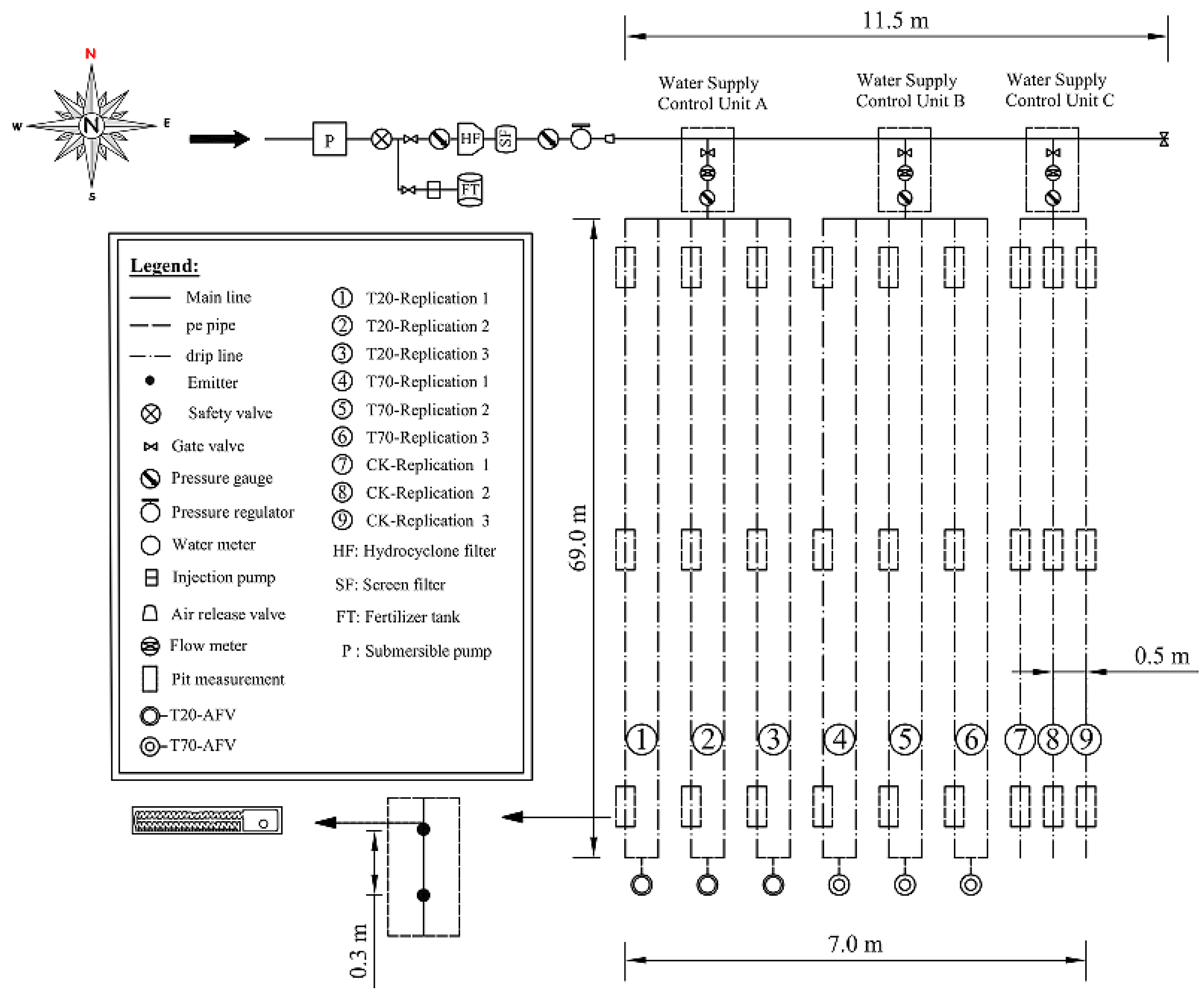

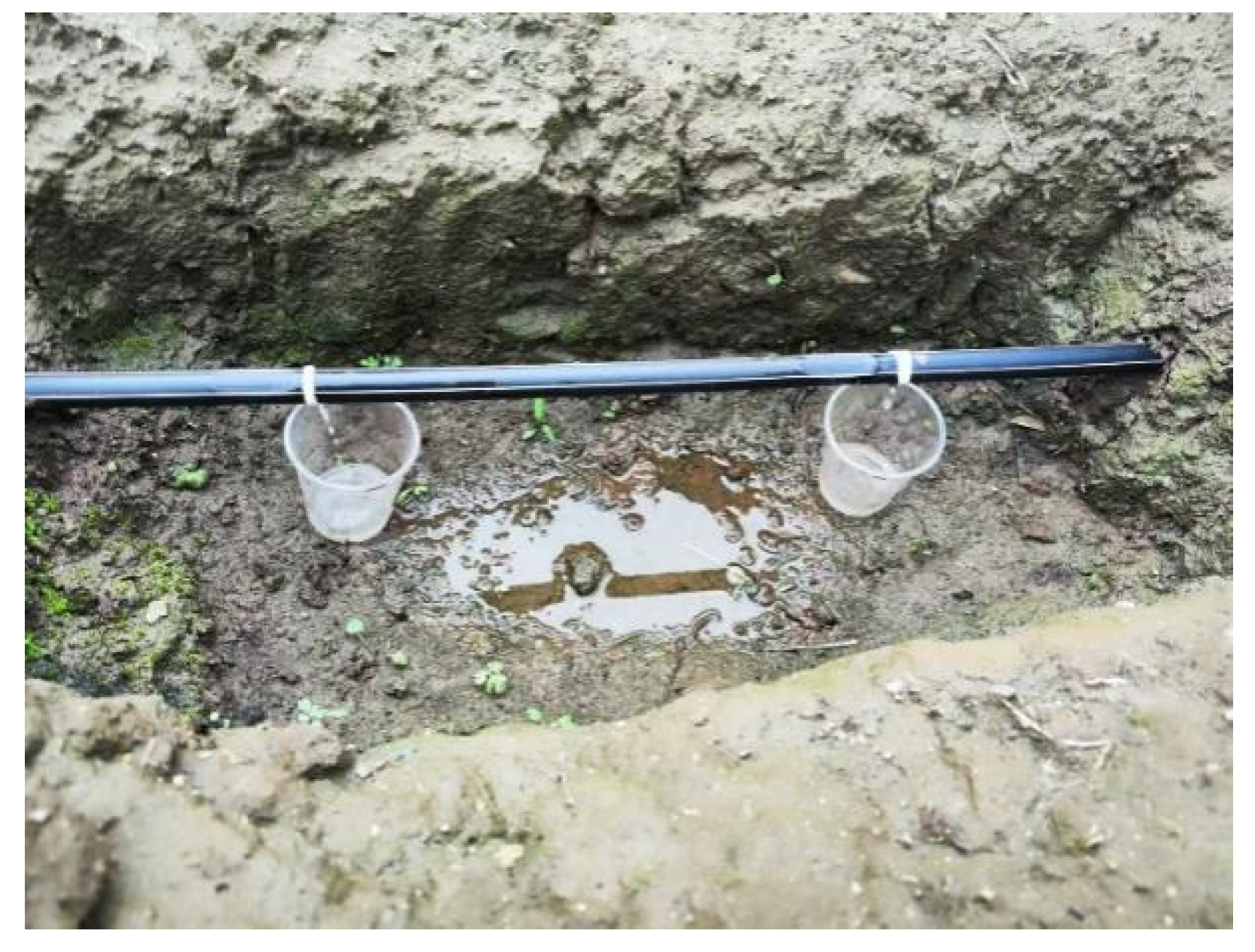
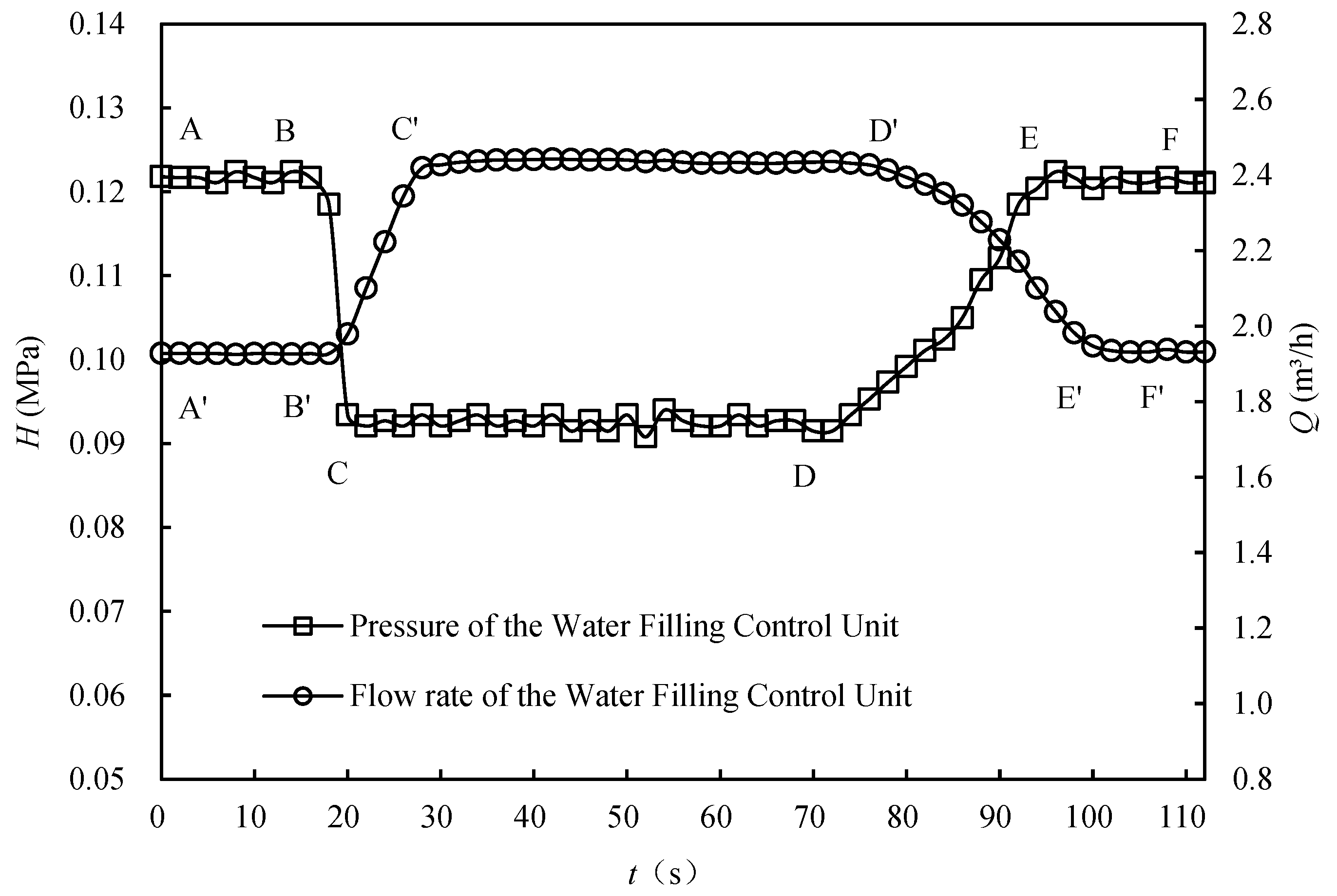

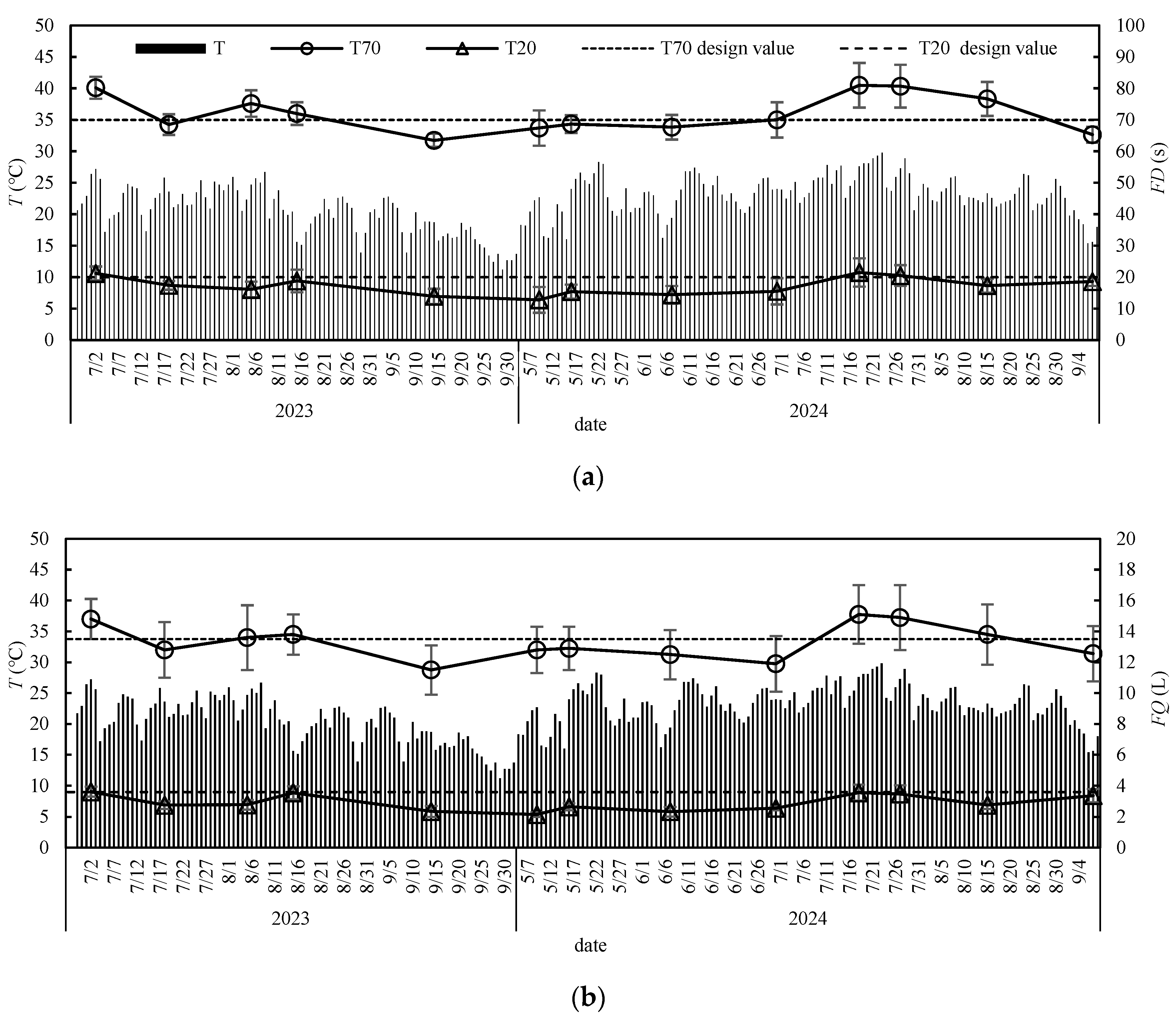


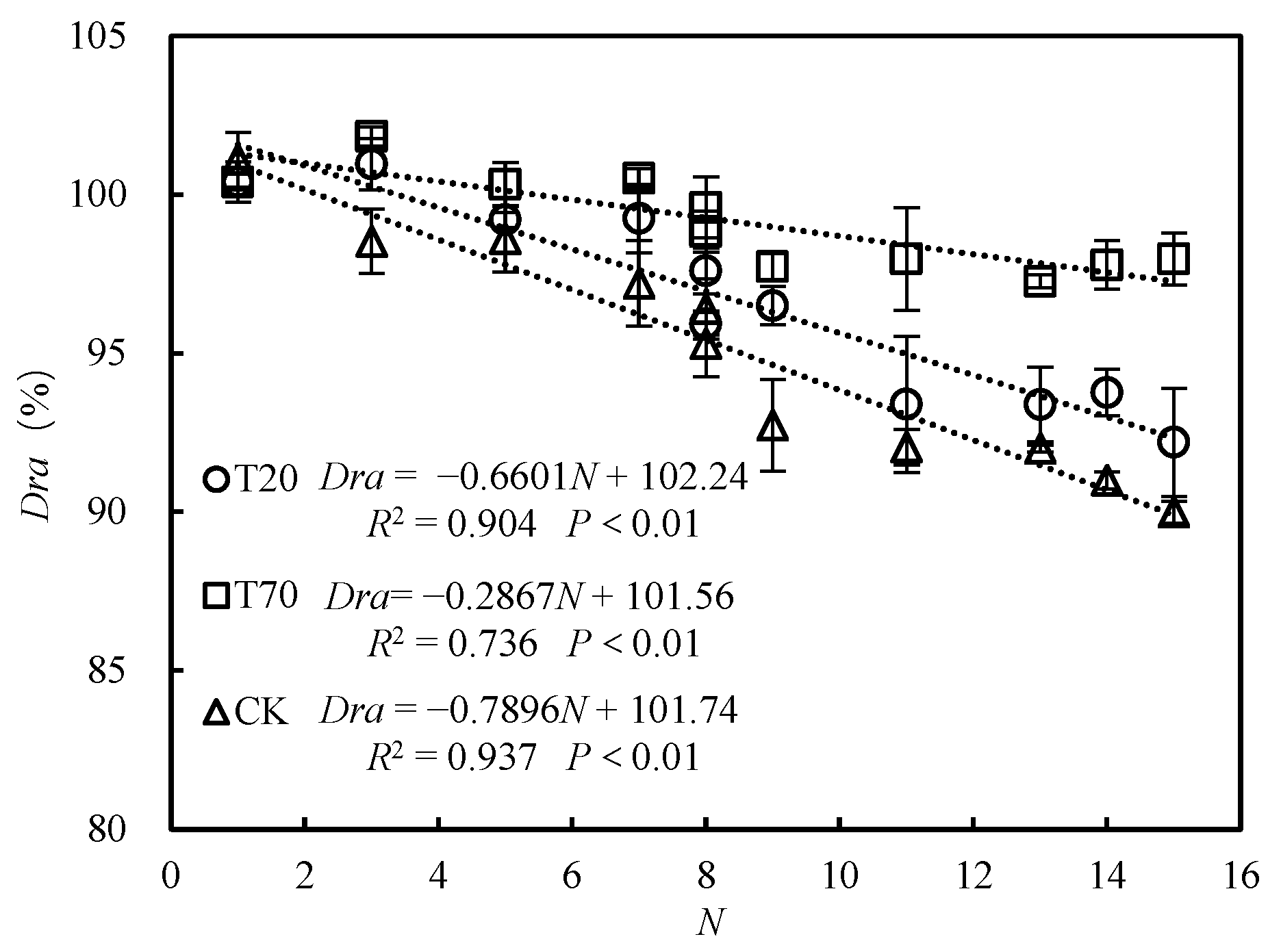
| TN (mg L−1) | TP (mg L−1) | TSS (mg L−1) | TDS (mg L−1) | TH (mg L−1) | CO32− (mg L−1) | HCO3− (mg L−1) | Cl− (mg L−1) | SO42− (mg L−1) | pH |
|---|---|---|---|---|---|---|---|---|---|
| 1.05 ± 0.03 | 0.08 ± 0.01 | 42.8 ± 2.6 | 640 ± 31 | 375 ± 19 | 11.9 ± 0.5 | 216.0 ± 14.0 | 17.2 ± 1.1 | 33.2 ± 2.1 | 7.5 |
| 2023 | 2024 | ||||||||
|---|---|---|---|---|---|---|---|---|---|
| Date | Irrigation Volume (mm) | Fertilizer Amount (kg/ha) | Date | Irrigation Volume (mm) | Fertilizer Amount (kg/ha) | ||||
| N | P2O5 | K | N | P2O5 | K | ||||
| 6/24 | 45.5 | 5/9 | 41.5 | ||||||
| 7/2 | 22.6 | 5/16 | 20.5 | 33 | 50 | 33 | |||
| 7/18 | 31.1 | 33 | 50 | 33 | 6/7 | 41.2 | |||
| 8/5 | 20.1 | 6/18 | 21.4 | ||||||
| 8/15 | 35.2 | 6/30 | 21.6 | 33 | 50 | 33 | |||
| 8/29 | 30.2 | 33 | 50 | 33 | 7/18 | 30.6 | |||
| 9/14 | 22.8 | 7/27 | 20.1 | ||||||
| 9/28 | 25.5 | 33 | 50 | 33 | 8/15 | 40.1 | 33 | 50 | 33 |
| 9/7 | 42.3 | ||||||||
| total | 233.0 | 100 | 150 | 100 | total | 279.3 | 100 | 150 | 100 |
| Treatment | FD (s) | Cu (%) | Dra (%) |
|---|---|---|---|
| T20 | 20 | 95.9 (0.6) b | 92.2 (1.7) b |
| T70 | 70 | 98.5 (0.7) a | 98.1 (0.8) a |
| CK | 0 | 95.3 (1.5) b | 89.8 (2.4) c |
| the whole system | 96.8 | 93.7 | |
| F | 6.4 | 43.2 | |
| significance | * | ** | |
| Clogging Level | Dra (%) | CK | T20 | T70 | |||
|---|---|---|---|---|---|---|---|
| Irrigation Events | Operation Years | Irrigation Events | Operation Years | Irrigation Events | Operation Years | ||
| slight clogging | 80~95 | 9~28 | 1~3 | 11~34 | 1~4 | 23~75 | 3~8 |
| moderate clogging | 50~80 | 28~66 | 3~7 | 34~79 | 4~9 | 75~180 | 8~20 |
| severe clogging | 20~50 | 66~104 | 7~12 | 79~125 | 9~14 | 180~284 | 20~32 |
Disclaimer/Publisher’s Note: The statements, opinions and data contained in all publications are solely those of the individual author(s) and contributor(s) and not of MDPI and/or the editor(s). MDPI and/or the editor(s) disclaim responsibility for any injury to people or property resulting from any ideas, methods, instructions or products referred to in the content. |
© 2025 by the authors. Licensee MDPI, Basel, Switzerland. This article is an open access article distributed under the terms and conditions of the Creative Commons Attribution (CC BY) license (https://creativecommons.org/licenses/by/4.0/).
Share and Cite
Li, Z.; Mo, Y.; Wu, F.; Gao, H.; Wang, R.; Wang, J. The Effects of an Automatic Flushing Valve on the Hydraulic Performance of a Subsurface Drip Irrigation System for Alfalfa. Agriculture 2025, 15, 1107. https://doi.org/10.3390/agriculture15101107
Li Z, Mo Y, Wu F, Gao H, Wang R, Wang J. The Effects of an Automatic Flushing Valve on the Hydraulic Performance of a Subsurface Drip Irrigation System for Alfalfa. Agriculture. 2025; 15(10):1107. https://doi.org/10.3390/agriculture15101107
Chicago/Turabian StyleLi, Zaiyu, Yan Mo, Feng Wu, Hao Gao, Ronglian Wang, and Jiandong Wang. 2025. "The Effects of an Automatic Flushing Valve on the Hydraulic Performance of a Subsurface Drip Irrigation System for Alfalfa" Agriculture 15, no. 10: 1107. https://doi.org/10.3390/agriculture15101107
APA StyleLi, Z., Mo, Y., Wu, F., Gao, H., Wang, R., & Wang, J. (2025). The Effects of an Automatic Flushing Valve on the Hydraulic Performance of a Subsurface Drip Irrigation System for Alfalfa. Agriculture, 15(10), 1107. https://doi.org/10.3390/agriculture15101107








